Evolution's Extinction Engine
Part 6 – Natural Selection
Welcome back to another session of Literal Genesis, whereas our tagline goes, we strive to hold firmly to Scripture and hold loosely to theories. Why is that? Because scripture never changes. In fact, Hebrew says that,
"Jesus Christ is the same yesterday and today and forever."
- Hebrews 13:8
That part doesn't change. But you know what does change? Theories. Theories made by us flawed humans, including myself. They're so fluid and they change all the time. We don't want to put our anchor on those types of things. We want to actually anchor firmly in Scripture so that "...we're not tossed around," like James says in Ephesians 4:14, "driven about by every wave of doctrine."
So, that's kind of the purpose of this series here. We want to make sure that you're equipped, that you can be confident, especially in the early history of Genesis.
Now last session, we sort of looked at the odds. What are the odds that a single cell could form by chance or even a single protein? And we looked at how a cell is amazingly like a city, in intricate detail.
In this session, we're going to actually look at the second part of the formula of evolution. So, the first part of that formula had to do with mutations. And whenever you hear mutations, you always hear of what follows- natural selection, right? Mutations and natural selection.
We haven't talked about natural selection up to this point, but if it's a part of this, somehow, magical formula that's supposed to change microbes into microbiologists over eons of time, then we need to include it, we need to talk about it, we need to figure out what it is.
Now, just a little recap, going back several sessions. We talked about a manual, and this manual representing DNA that's in us and all of our cells. Every living thing has DNA, has blueprints. And the example that I want to use today is a motorcycle.
Let's say we have a manual on how to make a motorcycle, how to put it together, assemble all the parts and get it up and running. That's going to be a manual of a certain size. Now, if evolution is true and this motorcycle represents a single celled organism- again, never mind how that organism got here. Darwin didn't know, nobody knows, right? Well, unless you believe Genesis, then you know. Well, let's just say the motorcycle represents a single celled organism. He's got an information booklet of yay size. If this motorcycle is going to become something like a jumbo jet over eons of time, we have to add to the manual, don't we? That's just logical, there's no way around that. I can't take this manual and make an airplane from it. It could never happen.
If this manual is eventually going to make an airplane, I've got to add a lot of information. And if you remember back to our session when we did this thought experiment, it's not just the manual on how to put the parts together, assuming all the parts are in the hanger. It's how to go out and mine the parts, how to create every part step-by-step, all the tools, all the nuts and bolts, everything that we need. So a lot of changes need to happen.
And remember, what was the engine that made those changes? In my example, I said it was a blind three-year-old. You put a blind three-year-old in the room here with this motorcycle manual and give her a pair of scissors, some tape and a marker and say, how about it? In 24/7 she starts making changes to the manual. Do you think over any period of time that she could come up with this, how to make and fly and mine and build all the parts to build a jumbo airplane? It's not going to happen. It's never going to happen in that process.
So that's the mutations part, that we have mutations in our DNA, we have copiers and other things, we have external influences that could actually damage our DNA. Those things tend to take organisms in a downward direction.
Well, what about the information we need to build that single cell? If you're going to go from one to the other, you need an overall increase in useful information. Does that make sense? You can't stay with this information. You've got to have new information, just like that single cell, that amoeba, it's got to grow into a human over time. You need more information. It doesn't have eyes, it doesn't have lungs or a circulatory system. It doesn't have a brain, right? Somehow you need instructions on how to build those things if evolution is going to be true. So mutations is kind of half the equation. The other half is natural selection. Somehow these two together are supposed to accomplish this over time.
We have already seen that mutations are not going to do it. In fact, there are many scientists who've been working for the last few decades on trying to figure out another mechanism outside of mutations and natural selection. So far, nothing has really stuck, but there are alternative theories. For now this remains the dominant paradigm, this Darwinian's macro evolution, or what we call it: Neo Darwinian or the New Darwinian synthesis.
Natural Selection's Role
Okay, so what is natural selection? We talk about natural selection. Here's what it is not: It is not a mind, it is not a force. We're not talking about something from Star Wars here, that has an effect on nature. Natural selection is more of an observation. And I've got an analogy to kind of describe that here in a moment, but kind of like evolution in general, where evolution is mindless, it's non-intelligent, it has no purpose, it's based on chance and randomness. Natural selection is sort of the same way, but it's more of an observation of the first half of the formula.
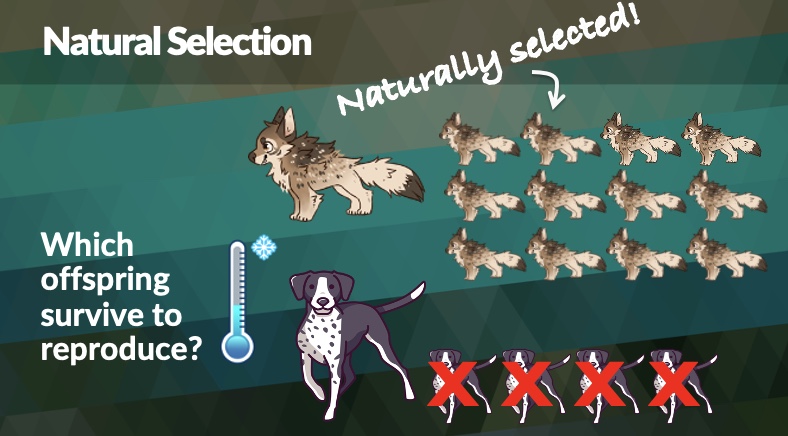
To give an example, if we start with a couple of dogs, you can see one has long fur and the other has short fur.
And by the way, where is the information stored within these dogs, on long fur and short fur? It's in the genes, it's in the DNA, right? So one dog has the genes for long fur, the other dog has genes for short fur.
And let's say these dogs have some puppies, some baby dogs. And by the way, evolution, natural selection, they require the idea of reproduction. None of it works if you can't reproduce, which does bring up a lot of interesting questions: How did that single cell divide and replicate? How did it turn into genders that have different parts and different reproduction systems? It's boggles the mind.
We have both dogs here. Let's say they have some puppies: short fur, long fur dogs. And let's say that the temperature suddenly changes. It turns frigid cold, minus 60 degrees Fahrenheit, really, really cold. Which is going to be the more likely to have offspring that survive? Would it be the long hair fur, or the short hair fur? Who's going to be most likely to live through this sudden change in climate? It's not going to be the short hair dogs. They're not going to make it.
I know, I'm a dog lover, this is a sad illustration, isn't it? But this is how life is. The short hair dogs will never make it in these sub-zero climates. What we are left with is the long hair dogs who have offspring, who mate with other long hair dogs, and they have offspring. And so what we end up with is a bunch of dogs who have genes for long hair. Well, what happened to the genes for short hair? They're gone. In this environment, they're gone forever and you can never get them back once they're lost.
And that's the way natural selection works. The long hair dogs have been selected for survival. The short hair dogs have been selected for extinction. Now, who's doing the selection? Is there a mind behind this? Of course not. The climate happened to have changed and one survived over the other. So you can see natural selection is really more of like a hindsight process. We can see why the short hair dogs disappeared from this climate and why the long hair dogs thrive. They'd been selected naturally, of course, right? It's an observation.
Now, we'll say this natural selection is observable. In fact, the first person that we have in history that wrote about natural selection was Edward Blythe. He was a Christian who believed in creation, who believed in the Bible. He came up with it and wrote about it 25 years before Darwin. Darwin just used it in a different way and actually popularized it.
So as a Christian, this doesn't bother me. This is something observable. I have no problem with natural selection at all. But does it help mutations in any kind of way create this idea of goo to you? From the primordial soup to human beings over billions of years of time?
Well, let's ask a few more questions about natural selection. So going back to our dog example. And as I stated, it's really all about reproduction. If you're not going to have offspring, it doesn't matter how fit you are or how good looking you are, how strong you are, or how popular you are in the climate that you're in. If you're not going to pass on your genes, then it doesn't matter in terms of evolution and natural selection. So this is all about offspring. And sometimes we think about natural selection as being survival of the fittest. I really don't like that term because it has nothing to do with physical fitness. We often think, oh, the bigger, the stronger species are going to survive over the smaller and weaker, which has nothing to do with it.
If that weak or smaller species can have more offspring and those offspring can have more offspring, that's what it's about. And that's what natural selection needs to work against. So it's all about reproduction.
Now, you'll notice in our example of dogs, we started with dogs, long hair and short hair, and we ended with dogs, just long hair dogs. Now, think about that for a second. Did anything really change? We started with dogs, we ended with dogs. Natural selection selected one type of dog with the short hair for extinction, that's true, but nothing changed. We still have dogs at the end of the day. In fact information was lost. Those dogs that had genes to produce short hair, they're gone. They're out of the gene pool. They're gone forever. You can never get them back. So natural selection is a process that doesn't add information, does it? But evolution requires addition of useful information.
Remember that motorcycle manual? If it's going to become tons of manuals on how to create an airplane, we need to add information. Natural selection doesn't seem to do that. In fact, it seems to lock information out and that's what natural selection does. And again, when I say it does, there's no force, there's no person, there's no mind behind it. This is kind of like backwards thinking, or hindsight thinking. So natural selection actually removes information from the genetic population. It locks it out forever. You can never get it back.
How does this process work hand-in-hand with mutations then? That is a good question. In order to kind of answer that, I want to go back to a scripture here in Matthew 19:12. This is Jesus speaking. This may seem like an odd verse to talk about natural selection, but just stick with me. Jesus says,
"For there are eunuchs." And by the way, eunuchs, in case you don't know, well, we'll say a eunuch is someone who can't have offspring. They can't have children. And he says, "There are eunuchs who are born that way from their mother's womb, there are eunuchs who were made eunuchs by people, and there are eunuchs who made themselves eunuchs for the sake of the Kingdom of Heaven."
- Matthew 19:12
So we've got three types of people we're talking about here who can't have children either because they were made that way or born that way, or they choose not to have offspring. We'll look at it that way.
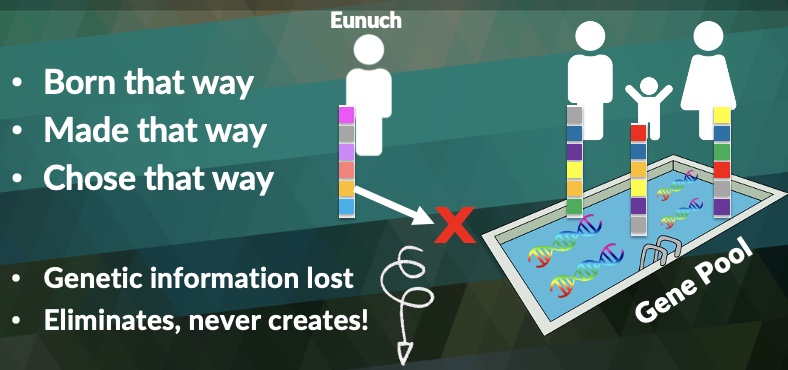
And so here's our three people: born that way, made that way, chose that way. And here's our eunuch. It doesn't really matter right now, which of the three they fall under because we're going to be talking about natural selection.
I want to compare the eunuch to a man and a woman who have offspring, who have children. Now we need to look at this from the genetic perspective, because remember if the DNA manual doesn't change, we're always going to get a motorcycle. We need an airplane. If the DNA doesn't change in a bacterium, we're always going to get a bacterium, we're never going to get a basketball player, it doesn't matter how long of time we have, it's got to change the manual.
So, now these are not chemical test strips that you use to test your pool water with. I apologize for the illustration. This is my idea of how to illustrate DNA in kind of a simple way. So if we start with the eunuch here, the person who is not going to have offspring, they have a unique combination of DNA represented by the different colors.
Now, obviously I wasn't going to put 3 billion color swatches on here, that's too big. So this represents DNA in a small way. And the man and the woman who have an offspring, you can see, they also have unique DNA, a combination of DNA that they received from their parents and their child now has a unique combination of DNA from its mother and father.
So, all four of these individuals have uniquely combined DNA through the process of heredity. Now, what happens when the child grows up and does the same thing? Marries and has offspring. Well, they're just contributing to the gene pool, right? There's an overall concept of a gene pool.
So all this wonderful variation and beautifully-different combinations of DNA end up in a pool, that when you go choose a husband or a wife, you're drawing more of that variation out of the pool. The longer time goes on, the more wonderful combinations and variations you have here.
And I can see that as being a part of God's design, starting with just one man and one woman, how we have all the different skin types and features and short and tall and different colors of hair, all of that, right? The more time goes on, the more variety you get out of these genes. It's absolutely fascinating.
Well, what happens to the eunuch's very unique combination of DNA. Well, it doesn't contribute to the gene pool, does it? Where does it go? Well, it goes nowhere. So the eunuch will be naturally selected for extinction, right? Regardless of whether he was born that way or made that way or chose that, it doesn't matter. His genes are not being contributed to the gene pool.
And so natural selection eliminates, it never creates. Let that sink in just for a second. It eliminates information, but never creates. There's no example that we have of natural selection creating new information in DNA, a new organ, a new type of appendix or a new better way of breathing, for example. It never does those things, but it locks out information, which is just the opposite.
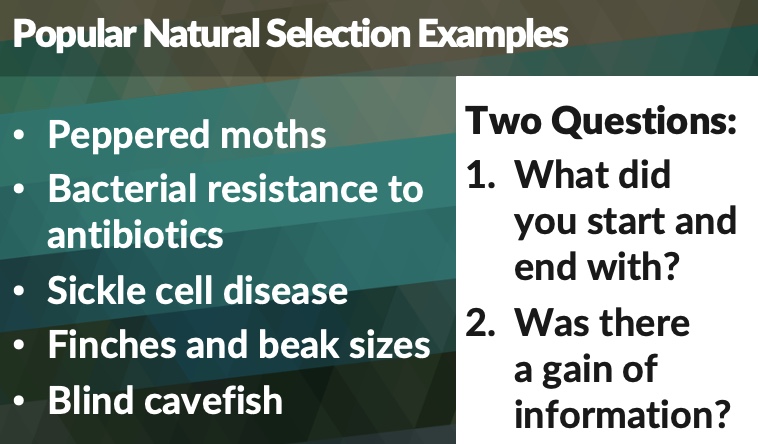
Now, there are lots of examples that you may hear from time to time on natural selection. I've listed a few here, the peppered moths, I put at the top of the list. I have to put that at the top of the list. If you're not familiar with the famous peppered moth illustration, that goes something like this: In pre-industrial times of England, where they had trees and these peppered moths, we had two different kinds of peppered moths basically, we had a dark variety and a light variety. And as the story goes- and I call it a story for a reason, I'll tell you in a moment- these moths would rest on the tree trunks during the day. And these tree trunks were lighter in nature prior to the Industrial Revolution.
And so the lighter moths would blend in more with the tree trunk. So birds would come along and eat the darker ones. Now what happened during the Industrial Revolution was all the pollution from the factories and everything being spun up, it darkened the tree trunks and not darkened from the smoke, there's a chemical reason why they were darkened. And what happened was now, all of a sudden, the darker ones blended in better on the tree trunks and the lighter ones were more exposed. And so the birds preferred the lighter ones, presumably because they could see them easier. And when they captured moths throughout this industrial evolutionary process, they noticed that the population of the darker moths increased greatly and the population of the white moths were dwindling down and down, getting lower and lower.
So in terms of natural selection, what happened? The darker moths were selected for survival. The whiter moths were selected for extinction, or at least they were headed that way. Now, as it turns out, the story was kind of fabricated, kind of made up. It turns out these moths don't rest on the tree trunks during the day. And in fact, they tend to be active at night, not during the day. And the pictures that were posted with these moths on the tree trunks, it turned out they were dead moths which were glued to the tree trunks. But regardless of that, regardless of whether it was a hoax or not, it doesn't matter, the concept is still the same.
We started with peppered moths, and what did we end with? Peppered moths, right? We started with genetic information for light and dark. What did we end with? Well, if the story had played out, we would have ended with only genetic information for darker moths. Where did the genetic information for the lighter moths go? They were gone, they were lost. Natural selection would have locked it out of the gene pool forever to be lost, never to be retained again.
The second one I'll talk about is bacterial resistance. So, no longer is peppered moths the poster child of evolution in action. Don't fall for the bait and switch. Now, this is true regardless of anything you're talking about, any subject, right? You start with one type of concept and word, and then somewhere midway terminology is switched. This is exactly what happens with peppered moths. They talk about natural selection, but somewhere in the conversation, it switches to evolution in action. Really? That's a macro evolution. How is that macro evolution? Ask the critical questions. Don't fall for the bait and switch.
So now bacterial resistance has floated up to the top. I was watching some lectures this past week on natural selection by a very prominent scientist. I was surprised to see this one mentioned, it's still mentioned, even though it's kind of been known to be a hoax and fabricated, and this one was mentioned right after it, bacterial resistance to antibiotics. What does that mean? How is that natural selection? Well, if you take a bacterial cell that, let's say it's inside our bodies and it's not a good bacteria, let's say it's a bad bacteria, it's going to do us harm, we don't want it there, we need to get rid of it. One way to get rid of it is with antibiotics.
Now, there are several ways you can kill bacteria with antibiotics. One of those ways is that once the antibiotic is in your system, it's attracted to the bacteria. How does that work? Well, the bacterium's shell, if you will, that kind of surround the bacterium, has a negative charge. So they create, this is ingenious, right? They create an antibiotic as a positive charge. So they naturally want to go together. And once the antibiotic is attached to the bacterium, it can begin the process of killing it.
Another way is to get the antibiotic into the cell, into the bacterium. And it does that through these little pores, we call transports. The surface of the bacterium has multiple transports that need those, so that it can bring in nutrients. Well, we kind of trick it. We create an antibiotic that looks like a nutrient, so it readily accept it into the cell. And from there, for example, one of the antibiotics will inhibit the bacterium from performing cell maintenance. It makes it where it can't produce a part that it needs to maintain the cell. Well, that's great.
What happens if a mutation happens in a bacterium that alters one of those transport mechanisms, makes them not work at all, or makes them work very poorly and inefficiently. Now when that antibiotic reaches the bacterium, either it can't get into the bacteria, or only part of it is able to get in, making it ineffective. And so the bacterium evolves resistance to the antibiotic. That's the way it's worded. But we need to ask the question. What really happened? What happened is we had something mess with the manual of the bacterium, the bacterium doesn't function like it did before.
When you damage those transport systems, not only do we lock out antibiotics, but now we make it harder for the cell to receive nutrients. Did that really evolve? Is that really how it's going to work its way up to becoming a basketball player over billions of years, by damaging processes in the DNA that it needs to survive? That doesn't sound like a good process.
So we need to start asking two questions. When we hear about these natural selection examples. Again, natural selection is observable. I have no problem with that. That's good science. The first question is: What did you start and end with? We started with peppered moths. We started with bacterium. We ended with peppered moths. We ended with bacterium. What really changed? Nothing changed. If you're going to go from one to the other, you've got to have massive change. And secondly, was there a gain in useful information? Well, in the example of the peppered moths, we've seen that the genes that produce the lighter colored moths, those were locked out. Those were lost forever. In the case of the bacterial resistance to antibiotics, we had a wreck, we had a damage in the DNA that limited the bacterium when taking in nutrients, right? So that's not a gain of information. That's a destruction of existing information.
Two very simple questions for me to ask. We can't take any one of these examples and say, "Yeah, but if we use our imagination and imagine down the road, when they have a thousand of these different kinds of changes, that's what evolution is." Well, that's not observational science. In fact, that takes a lot more faith to believe than it does, "In the beginning God created." Something that matches our observation: that things started out at their highest possible peak in terms of fitness and center of the world, God's creation, Adam and Eve, they messed up, they disobeyed God. And God said, now things are going to be different. And that's the world we see. We don't see that perfect world that existed at the pre-sin time of Adam and Eve. We see a fallen world. That matches observation. This is much better than the idea that these processes can somehow mold single cell organisms into human beings over time. Here's a quote from a couple of scientists here from the Department of Zoology in Cambridge. It say,
"Nonetheless, most studies of recent evolution involve," What's that? "The loss of traits and we still understand little of the genetic changes needed in the origin of novel traits."
- Nicola J. Nadeau and Chris D. Jiggins
Trends in Genetics, Department of Zoology
University of Cambridge
So, to put that in everyday language, it says, when we look at these mechanisms of evolution, we don't see the gain of new features, new organs, new traits. We see the loss of those things. We see the damage to those things. And it says, by the way, we still understand very little of the changes that you need in the DNA to produce something brand new.
Again, that motorcycle to an airplane, you need brand new things. Motorcycles don't have wings. So, where do you get the wings? Same thing for that single cell bacterium. It doesn't have feet. Where do you get feet? It doesn't have a skeletal system, right? Where do you get these new novel traits? And they're admitting that, we don't know. We just don't know. We know very little of how that works.
So natural selection, again, it's observable. This is good science, but when we say natural selection, along with mutations, can somehow create all these grandiose things in life that we see, that doesn't explain it. Not as Darwin thought it did. In fact, the more we learn, the more the goalposts keep getting moved further and further away because the deeper we go into the cell and the more we learn how complex things are in there, the goalposts don't get closer to the evolutionary ideology. They get further and further away. And in fact, evolutionary ideology gets further away. God, to me and my mind, just gets magnified. The deeper we look and the more we understand His creation. So natural selection. Yes, absolutely. Macro-evolution, no, I don't believe you can get there from here.
Intelligent Design
So, what does it mean then when we're looking at the cell and maybe we don't see the evidence of macro-evolution, what do we see? Well, we should see some kind of design. We looked at all the videos in the last section of how the cell is like a city. It was absolutely fascinating, right? It has all the hallmarks of intelligent design. Well, how do we know when we're looking at something, if it was designed or if it came about by nature? I have a few very simple examples.

Take a look at these pictures. The first picture on the right, what do you see as you're looking at that, what pops out at you? It looks like a face, doesn't it? You can kind of see an eye structure up here, obviously, what looks like a nose and maybe a mouth down here. This kind of piece here, it looks like it could be an ear. I say could be, it doesn't exactly look like a face, but it really does kind of look like a face. This particular rock formation is found on the island of Maui in Hawaii.
Now look at the left image. There's another rock formation that we can compare it to, that really does look like faces. They have all the things you would look for in a face. In fact, you could look at it from different angles, and it would still look like a face. This particular rock formation, the image on the right, when you go around to the other side, it no longer looks like a face. It only looks like a face from this particular angle.
So the question is, which one was designed and which one was formed completely by natural processes? This is an easy one. You should get this one. Obviously, the one on the right was formed by nature, and the one on the left was intelligently designed. It has specified complexity.
I think that's what we're looking for in determining whether something was designed or not. They're both made out of rock. They were both carved, one by wind and erosion and the other by human hands, but one has more specified complexity.

All right, how about this one? Looking at two different beaches. The one on the left- and I actually like these, the designs, when you're out on the beach and the waves come in and then they go out and you see what's left behind. I could look at these for hours, they're incredible, but compare that to the design we see on the beach on the right. Now, which one was formed by nature, which one was formed by a mind or in this case, a human. This is a no-brainer. When we look at this, we never see nature with this type of specified complexity- I should say, we see patterns, sure, and some of them are quite beautiful. Look at the crystals in quartz, absolutely stunning images, but we never see anything like this. So obviously the one on the right is designed. The one on the left is formed by natural processes.
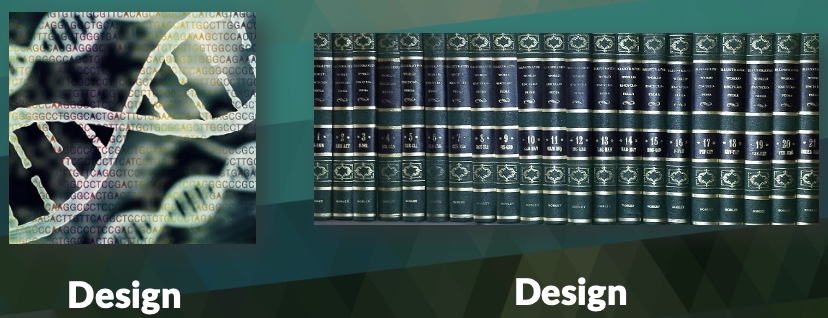
We'll kick it up a notch, make this a little harder. So here on the left, we've got DNA, which is 3 billion base pairs, or look at it this way, it's 6 billion genetic letters, right? Chemical letters in an ordered, specified code to build living things, to maintain living things, to regulate living things. On the right, we have a set of, let's say, encyclopedias. Which one was formed by nature, completely by random chance processes, and which one was designed? So what I've given you here is what's called a false dilemma. I'm making you choose when actually it's clear that they're both designed.
These books, no one would ever say, would write themselves no matter how much time you give them. No matter how much ink and paper you put in a room and shake it up, you're never going to get this. Well, why would we think this could come about by itself? Three billion base pairs of a code, read three letters at a time that produce all these amazing structures in the cell. This has all the hallmarks of intelligent design. And this is why many scientists no longer believe that this could have happened by chance on earth. They know this is designed by a mind. You can't get around it. Codes do not create themselves. We talked about that in previous sessions, they always all result from a mind.
So where did this come from? Well, we have a quote from Richard Dawkins. He's a very famous outspoken atheist, and against all things God and Christianity. He was interviewed by Ben Stein in a movie called The Expelled. If you haven't watched it, I highly recommend it. It is very educational. Here's what he had to say about this idea of a grand designer. He said,
"It could be that at some earlier time, somewhere in the universe, a civilization evolved by probably some kind of Darwinian means to a very, very high level of technology and designed a form of life that they seeded onto, perhaps, this planet. And I suppose it's possible that you might find evidence for that if you look at the details of biochemistry, molecular biology, you might find a signature of some sort of designer."
- Richard Dawkins
What is he saying here? He's saying that when we look at the cell, when we look at DNA in particular, that there is evidence of design. If we look close enough, which hopefully in this series you've seen that. We've taken kind of a high-level look, but we've looked deep enough to see that it does have all the bearings of a designer. I want to highlight a few things in his quote to kind of draw out the certainty of what he's saying about this.
"Some earlier time." Is that specific or non-specific? That's very non-specific. "Somewhere in the universe." Does that pinpoint it down for you? Probably some, not a lot of confidence there. And, "suppose it's possible," "you might find evidence," "you might find a signature." It's amazing to me how, and Richard Dawkins is very intelligent. I actually enjoy hearing him speak when he talks about biology, but when he's getting around to the issue of design and how things could have formed by chance, it's unnerving.
This does not sound very scientific and it doesn't sound very confident to me. But he's saying, if you look close enough, you'll see that there's a signature in the cell, which by the way, is a book by Stephen Meyer, I highly recommend it, it's a very, very thick book, a lot of words, very much worth the read. But he's saying, if you look close enough, there's a signature in the cell that would clue us in that there was a designer, that designed it.
I totally agree with that. What I don't agree with is it was some alien somewhere else in the universe. Again, that's kicking the can further down the road. This is what he's getting at, is this idea that extraterrestrial beings created it. Just back it up all the way, right, there must have been a Creator to create everything.
I want to end with this verse in 2 Peter, because I get asked this all the time, especially by Christians. Well, I talk to atheists, I talk to scientists of all sorts, and it amazes me at the lengths that some will go to ignore the evidence, to not follow the evidence where it clearly leads, and they want to know why. And I always refer them back to these verses. Peter says,
"First of all, you must understand this, that in the last day, scoffers will come scoffing and indulging their own lust."
- II Peter 3:3
Do we have scoffers today? Do we have people that scoff? "Oh, you're a Christian. Oh, well, what do you believe about creation? Oh, you believe God created everything. Oh, you believe He did it in six days" Then they scoff and they make fun. And hopefully throughout this series, I've given you some scientific evidence and examples to show that this is the more logical way to believe, but there are scoffers and that'll never stop. That'll never end as long as there are people on the earth.
And he goes on,
"And saying, 'Where's the promise of His coming, forever since our ancestors died, all things continue as they were from the beginning of creation.'"
- II Peter 3:4
In other words, Peter's saying that these people who scoff look around and say, "Today was like yesterday, yesterday was like the day before. It was like the year before, it was like the century before. It was like eons of time before, things have just been going on the same. Where's the promise? Where is this Creator of yours? That's supposedly going to come back."
Peter says, and this is what I want to key in on:
They deliberately ignore this fact, that by the word of God, heavens existed long ago and earth was formed out of water and by means of water.
- II Peter 3:5
What does that sound like? Go back and read the first chapter of Genesis, read the creation account, where "the Spirit of God was hovering over the waters."
Peter's reaffirming that, this is how God created the world. And He did it by water and out of water. And he says, "They deliberately ignore this fact." In other words, they suppress it. In fact, Paul uses different terminology when he says pretty much the same thing, that they suppress the truth, in Romans chapter 1 and 2.
And to me, I get this idea of a beach ball. You take a beach ball to the ocean or a swimming pool, and just try to hold that down under water. Even if it's a small one, it's really, really hard. You have to put a lot of effort into that. And this just reminds me of what Peter's talking about here, of folks, highly educated, smart folks, and pleasant to talk to, enjoy conversations, but they deliberately ignore the facts. They don't follow the evidence where it leads.
And Peter ends by saying,
"Through which the world at that time was destroyed by being flooded with water."
- II Peter 3:6
And I believe this is a good verse to somewhat end on, because in our next series, we'll talk about the evidences for a global flood, but Peter is just reaffirming what we read in Genesis 6, 7 and 8.
So again, if you're a Christian, and you've compromised in the early portions of Genesis, no, the creation didn't happen that way, there couldn't have been a worldwide flood. What do you do with 2 Peter 3:3-6? You have to somehow discount it, knock it out of your theology. And as I talked about in our second lesson, there's so many things you have to do this with in the Bible, if you compromise the early history in Genesis.
Can't See the Forest for the Trees
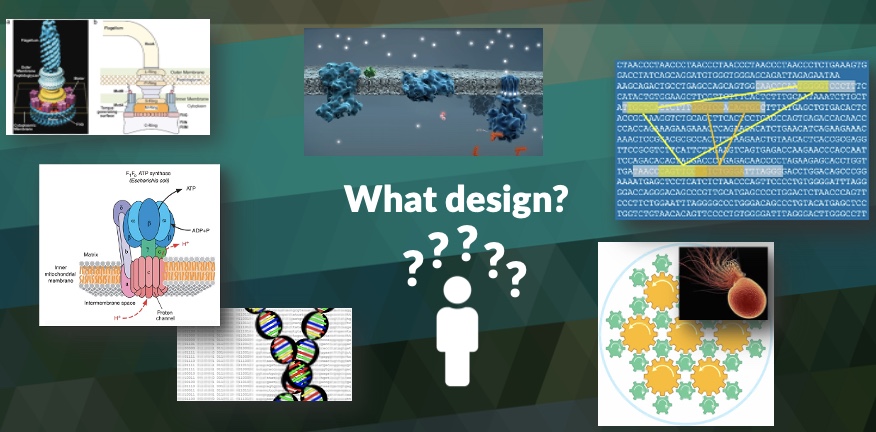
To wrap it up, within this series that we're talking about, I've kind of been focused on DNA and biology. And if you remember, we talked about things like the flagellum tail of the bacterium and all the intricate parts here, the rotor and stator and how it rotates, sometimes up to 100,000 RPMs. We looked at the electron and transport chain, part of the last few steps in the production of energy in our cells, and how these single protons and single electrons are shuffled around, top to bottom and inside now to create this energy process.
We looked at the four dimensions of a DNA. We've only looked at four. There are so many levels in here, code within a code within a code, pretty amazing. We looked at the actual ATP synthase motor itself being driven by single protons, which makes that rotate at 9,000 RPM, and it creates the ATP molecule at the bottom.
We looked at this single cell bacterium, the MO1 with its planetary gearbox, with its seven proton powered engine surrounded by 24 satellite gears. This is a planetary gearbox. This is designed, right? When we design gearboxes today, we just don't throw a bunch of parts in a box and say, "Well, I hope they work out into something."
And then the DNA code, which to me, if you don't think anything else is impressive, you've got to take a closer look at DNA, with the 3 billion coded letters of information, whose information we haven't fully tapped into. We thought we did it when we figured out where the genes were, right? And then we figured out, oh, wait, 25,000 genes, how do they produce 500,000 proteins? It got more complex. And then the 98% of the DNA we thought was junk. It turns out that most of it is read in some kind of way. It's not junk at all. It just keeps getting more and more complicated. And it's like the person who's looking at the forest and can't see the trees.
What trees am I talking about? Sometimes scientists, I think, are so close to their specific portion of science that they- whether it's synthetic chemistry, origin of life chemistry, evolutionary biology, geology- they're so focused on one little piece that they forget the bigger picture.
The bigger picture just screams of a designer, not something that could have possibly happened by chance. We'll end with our anchor verse here is Psalms 139:14, where David- I can picture David out in the field with the sheep, just reflecting on his Creator,
"I will give thanks to You, for I am fearfully and wonderfully made; Wonderful are Your works and my soul knows it very well."
- Psalms 139:14
And now that we're kind of at the end of this biological portion of our series, hopefully your intellect knows it as well. Something that cannot be denied.
Well, I hope you enjoyed the biological portion. In our next session, we'll kind of change gears a little bit and we'll look at evidences for a worldwide flood, for a global flood. We kind of talked about that a little bit in the first session, but we'll get a little deeper. You would think if there was a global flood, there must be some kind of scarring, some kind of evidence that we could go to look at. And we'll do just that.
Again, thank you for your attention, we'll see you next time.



